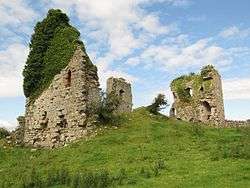Gleaston Castle
| Gleaston Castle | |
|---|---|
| Cumbria, England | |
|
Gleaston Castle ruins in 2015 | |
 Gleaston Castle | |
| Coordinates | grid reference SD261714 |
| Site information | |
| Owner | private |
| Open to the public | No |
| Site history | |
| Materials | Limestone and sandstone |
Gleaston Castle is situated in a valley about 0.3 miles (0.48 km) north-east of the village of Gleaston, which lies between the towns of Ulverston and Barrow-in-Furness in the Furness peninsula, Cumbria, England.
Structure
The castle consists of the remains four towers connected by curtain walls around a roughly rectangular courtyard. The walls are made of limestone quarried near the site, whilst details such as window and door surrounds are made of a soft red sandstone, the origins of which are uncertain although it is similar to that used in the construction of nearby Furness Abbey. The walls at the southwestern corner of the site have a clay core, as is usual in castle construction, but elsewhere the core is the same shingle mortar used to face the walls.
History
The castle is first mentioned specifically in 1389, although Sir John de Harrington, 2nd Baron Harington of Aldingham is said to have died at Gleaston in 1369. It is generally assumed that the castle was begun by his grandfather Sir John, 1st Baron Harington at around the time he was summoned to Parliament in 1326. It has been suggested that the Harington family may have found it necessary to move from Aldingham as the sea was eating away at the cliff on which their tower was built. Another alternative explanation is that they needed more room for a greater number of servants.[1]
It is possible that part of the structure is earlier and was built as a defence against the Scots who posed a serious threat to the area following Edward I's campaigns and Robert Bruce's assumption of the Scottish throne. The majority of the castle must surely have been built after the devastating 1316 and 1322 Scottish raids on the area as it was built quickly and poorly, with poor quality local materials, suggesting a lack of funds.
The castle was a walled enclosure 240 feet (73 m) long north and south, 120 feet (37 m) wide at the south end and 150 feet (46 m) wide at the north end. It had four corner towers, dressed with red sandstone. At the northwest the keep had three floors and a dungeon. The curtain walls, however, although 9 feet (2.7 m) thick were constructed of limestone rubble and were not very strong. In 1415 John Harington was granted a papal indult for a private chapel and a portable altar for mass. It is likely, however, that the castle would have had its own chapel before this date.[1]
The castle was the main seat of residence for the Lords of Aldingham until the death of William de Harrington, 5th Baron of Aldingham in 1457. The estate passed to William's daughter Elizabeth who had married William Bonville, 1st Baron Bonville of Shute in Devon and the title of 6th Baron Harington passed to their young son William. The Bonvilles made Devon their main seat of residence and Gleaston Castle was abandoned and quickly fell into disrepair. Gibson says that the castle was not occupied after 1458.[1]
William Bonville Jnr died along with his father at the Battle of Wakefield in 1460. The aged Lord Bonville was executed after the Lancashire victory at St Albans in 1461. So the castle fell to William's newborn daughter Cecily, who later married Thomas Grey, 1st Marquess of Dorset. Eventually, it fell to Henry Grey, 1st Duke of Suffolk who sold the castle and its adjacent demesne land to his bailiff Walter Curwen before he was beheaded for treason in 1554, by which time it was in ruins. In 1540, Leyland noted: "there is a ruine and waulles of a castell in Lancaster-shire cawlyd Gleston Castell sometyme longinge to Lord Harrington now to the Marquis of Dorset."[1] One of the southern towers may have been inhabited in the 16th century but by 1727, a farmhouse had been built adjacent to the southeastern tower. It appears Curwen sold the site to Thomas Preston, a local landowner, whose descendant Lord George Cavendish was probably responsible for creating much of the farm that can be seen today.
Gleaston Castle Farm became an important asset to the Cavendish estate after the Industrial Revolution made wheat and barley production highly lucrative. The farm was sold in 1920 to Thomas Barton Jackson of Bolton Manor, Urswick and again in 1927.
Today the castle is a scheduled monument and a Grade I listed building.[2] The ruins can be viewed from the roadside, but it is unsafe to enter the castle due to its state of repair. As of 2014, English Heritage considered the property to be in a very bad condition and in immediate risk of further rapid deterioration or loss of fabric: no solution had been agreed.[3]
See also
Bibliography
- Gleaston Castle 1
- Gleaston Castle 2
- Fry, Plantagenet Somerset, The David & Charles Book of Castles, David & Charles, 1980. ISBN 0-7153-7976-3
References
- 1 2 3 4 Leslie Irving Gibson (1977). Lancashire Castles and Towers. Clapham, North Yorkshire: Dalesman Books. p. 22.
- ↑ "Gleaston Castle", Gatehouse website, accessed 21 April 2011.
- ↑ Heritage at Risk Register 2014 North West (PDF). English Heritage. p. 36. Retrieved 24 September 2015.
External links
Coordinates: 54°07′59″N 3°07′57″W / 54.1331°N 3.1325°W
